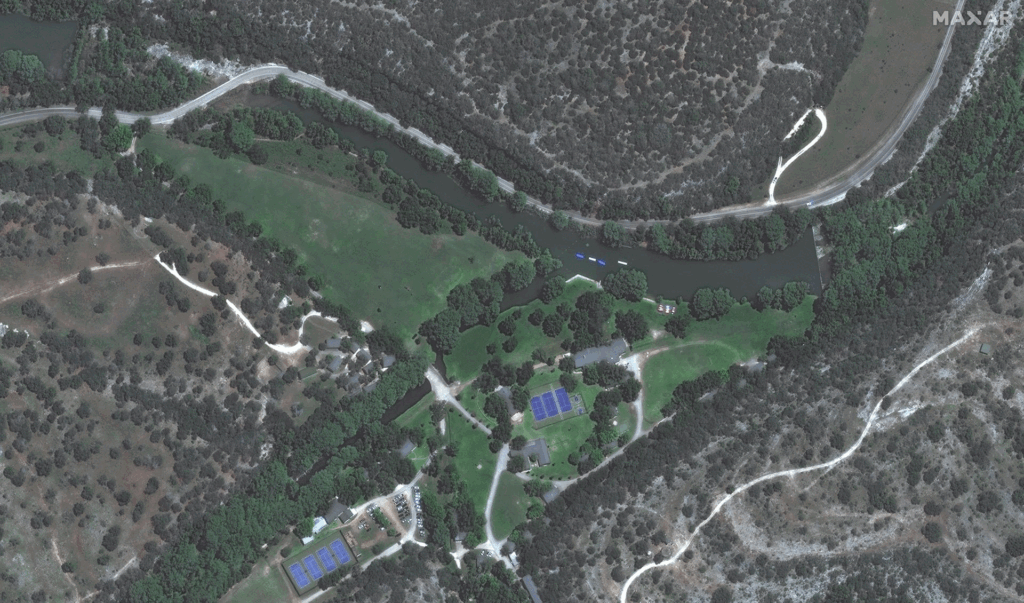As we watch the sun rise over the Guadalupe River, its once-calm waters are now a swirling torrent of debris and despair. The haunting calls from families searching for loved ones linger in the air, morphing the tranquil riverside into an echo of anguish. On a fateful morning in early July, flooding unleashed a catastrophic wave, sweeping away campers and counselors at the Camp Mystic for girls, nestled near Hunt, Texas. Ten campers and one counselor remain missing amid a staggering toll of over 84 confirmed dead.
CAMP MYSTIC: FAMILIES HOLD OUT HOPE AFTER FLOODING TRAGEDY
A Hallowed Ground Turned Haunted
Camp Mystic, a storied institution spanning more than 90 years, had long provided a refuge for young girls seeking adventure and camaraderie. But on July 5, 2023, the gentle sounds of laughter transformed into screams for survival. Eyewitness accounts describe a scene of chaos as the Guadalupe River rapidly overflowed, pulling unsuspecting campers from their cabins in the dead of night.
“The river rose almost instantly,” recounted Sarah Lewis, a counselor who witnessed the devastation firsthand. “It was like a nightmare unfolding before our eyes.” With the current sweeping away everything in its path, what was once a joyful summer experience became a treacherous fight for survival.
Scale of the Disaster
The sheer magnitude of this disaster is staggering. The Kerr County area, already grappling with seasonal storms, was hit by unprecedented rainfall, leading to the tragic circumstances at Camp Mystic. According to the National Weather Service, the rainfall in some areas exceeded 15 inches within 24 hours, a statistic that underscores the severe risks posed by extreme weather.
Dr. Emily Sanchez, a climate change expert at Texas A&M University, pointed to the disturbing correlation between climate change and increasingly violent weather patterns. “Events like these are becoming more frequent,” she noted. “We can no longer treat these floods as distant possibilities; they are part of our reality now.” Recent studies indicate that the frequency of extreme weather events in Texas has increased by 30% in the last decade alone.
Rebuilding Lives Amid Ruins
Families are left grappling with loss and uncertainty. At a makeshift community center, heart-wrenching stories continue to unfold. Parents search for answers, clinging to the hope that their daughters will return home. The emotional toll is palpable, with many families struggling to comprehend the enormity of their loss amidst the backdrop of a once-vibrant camp.
- 119 fatalities
- 170+ missing: An estimated 170 people remain unaccounted for, intensifying the urgency of ongoing search efforts.
- 95 deaths in Kerr County: Among those reported lost, Kerr County has seen the highest casualty figures, including 36 children.
A Community in Mourning
In the immediate aftermath of the floods, local officials mobilized to coordinate rescue operations. Search teams, comprising law enforcement, volunteers, and local firefighters, braved swift currents, combing through debris and downed trees. The process, however, has been slow and arduous, with several teams reporting notable challenges navigating the treacherous landscape.
“It’s heart-wrenching to see such despair,” said Captain Jonathan Harlow, a member of the rescue team. “Every piece of debris we turn over holds the potential for a lost loved one, and the weight of that responsibility is tremendous.” As the search continues, families remain on alert, spreading word through social media platforms, amplifying their pleas for information on missing girls and counselors.
Environmental Implications
The repercussions of this event extend far beyond personal tragedy. Environmental experts have highlighted how climate change exacerbates flooding risks, disrupting ecosystems and introducing long-term complications for regions like Kerr County, which has historically been vulnerable to flooding.
The floodwaters at Camp Mystic have scoured away vast tracts of soil, uprooting trees and obliterating flora along the riverbanks. Dr. Robert Jensen, an ecologist at the University of Texas, warns that “the ecological impact will be felt for years to come. It’ll alter habitats, affect animal migration patterns, and disrupt local fishing and tourism industries.” As a community grapples with the immediate effects of this disaster, the long-term environmental implications must also be addressed.
The Road Ahead
As search and rescue efforts intensify, fragility has settled into the hearts of families and communities. Analysts suggest an urgent need for investment in flood-resistant infrastructure and disaster response strategies that could mitigate future losses.
“Preparedness is key,” Dr. Sanchez emphasized. “We need to adapt our infrastructure to withstand what’s coming. It’s not merely about recovery anymore; it’s about prevention.”
In the days following the flood, a unified community spirit has emerged. Volunteers are stepping up to aid in recovery efforts, creating makeshift shelters, and providing food and counseling to those in despair. The resilience of Kerr County’s citizens shines through in the aftermath of disaster, embodying the tenacity needed to rebuild lives, homes, and a sense of safety once again.
As families hold out hope for those still missing, the river continues to flow, a testament to both the destructive power of nature and the enduring strength of community. The whispered prayers of families intertwine with the rustling leaves, echoing the sentiment that hope may indeed float even in the aftermath of overwhelming loss.









